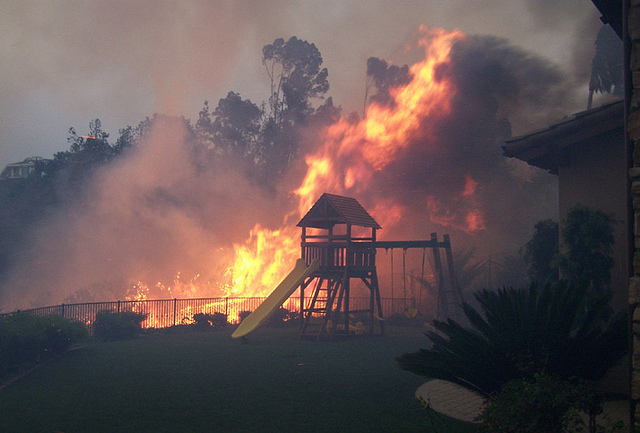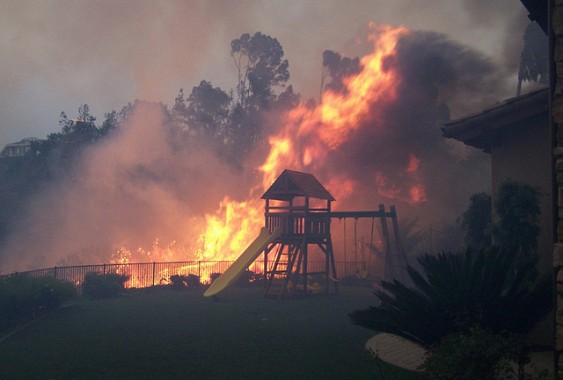Last summer the Taylor Bridge Fire outside Cle Elum, Washington, raged across 36 square miles of parched, crispy pine forest. It destroyed more than 60 homes and hundreds of families were evacuated. In the fire’s path was the 1890s homestead where my grandparents lived when I was a kid—a place where I made some of my fondest childhood memories. Even though our family no longer owns the place, it broke my heart to think of my old stomping grounds—the 120 year-old barn, the sun-darkened planks of the little granary—going up in flames. The fire devoured a colleague’s family cabin on the same hillside.
And then a couple weeks ago, I anxiously awaited news from my aunt and cousins who were hunkered down in their Hailey and Ketchum, Idaho, homes watching as a fiery apocalypse crept closer across the steep, dry hills that rise up in their back yards. Thankfully, firefighters contained the 173-square-mile blaze and my family is safe.
Both these events brought climate change impacts closer to home for me.
No wonder opinion research shows that firsthand experiences with extreme weather—and the experiences of close family and friends—make Americans far more likely to acknowledge that climate change is real, happening now, and is of great personal concern.
The bad news is that climate change is making for wildfires in the American West that are more severe and more difficult to fight. Some are calling the new climate-fueled wildfires “monster” or “mega” fires.
Climate change isn’t the only culprit creating the conditions for more severe and dangerous fires, but it doesn’t take a climate scientist or even a great detective to see the fingerprints of human-caused climate change on most wildfire crime scenes. Despite this, Media Matters analysis shows that the news media has largely failed to do the service of putting wildfires into the climate context for their audiences. This summer (as of July), only 6 percent of news stories about wildfires even mentioned climate change.
So, how should we reinforce the connections between climate change and the scary trend toward more frequent, wilder, hotter, bigger and less predictable wildfires? There are plenty of excellent resources to go deep on the science. (Some of the best are here, here, here, here, and here.) But we don’t need to get overly technical to lay out the basics. And people need to hear the basics.
The basics: Climate change is fueling dangerous mega fires.
Take California’s Yosemite Rim Fire, which has devoured over 222,777-acres, including vast swaths of Yosemite National Park (wreaking havoc on the region’s crucial summer tourist industry), destroyed 111 buildings, and threatened to disrupt water and power supplies to San Francisco. After visiting California’s Yosemite Rim Fire, National Park Service Director Jon Jarvis said climate change is leaving the West more vulnerable to catastrophic wildfires that are huge, “incredibly difficult to control and very expensive.” “This is a gnarly fire,” he said. “It’s got high attention, huge fuels, big flame lengths and lots of really, really dry, climate-driven conditions.”
In the state’s driest year on record, the Yosemite fire is now the fourth largest in California’s history. Andrew Freedman lays out just how drought amplifies a wildfire like this one.
As fire geographer Michael Medler testified in a congressional hearing, “On the fire lines it is clear, global warming is changing fire behavior, creating longer fire seasons and causing more frequent, large-scale, high-severity wildfires.” (That was back in 2007.) The science here is clear. Low snow pack and early snow-melt along with hotter temperatures and more severe droughts are making forests dry and highly flammable. More and more people live next door to these tinderboxes. Fire season now lasts two months longer and destroys twice as much land as it did 40 years ago, according to Thomas Tidwell, the head of the United States Forest Service. Western fires are straining firefighting budgets to the max.
And this is just the beginning. In coming years, things are projected to get much worse. (For one example, according to Harvard researchers, by 2050—when my daughter is my age—the area burned in the month of August could increase by 65 percent in the Pacific Northwest, and could nearly double in the Eastern Rocky Mountains/Great Plains regions and quadruple in the Rocky Mountains Forest region.)
Here are some simple, powerful sound bites to frame every possible conversation (and news story) about wildfires:
Monster Wildfires and Climate Change
Human-driven climate change is here, now, and we’re seeing impacts all around us.
Global warming is fueling dangerous “mega fires.” Climate change is leaving the West more vulnerable to catastrophic wildfires that are bigger, more dangerous, more difficult for firefighters to control, and more expensive than ever.
Global warming isn’t the only culprit, but the science is clear: the fingerprints of climate change are all over wildfire crime scenes. Hotter weather and heat waves, more frequent droughts, low snow-pack, and early snow melt add up to conditions that extend fire seasons and spike the risk of more frequent, larger, and more severe wildfires.










